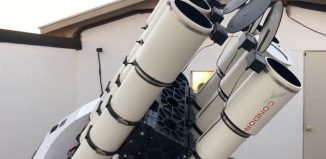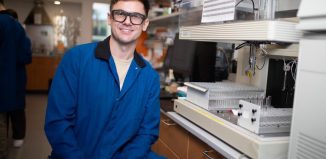CSHL’s Michael Schatz uses computer to study biology
Improving on genome sequencing, team studied parrot genome to understand human language development
Humans are constantly at war with our environment. No, not in a cut-down-the-trees-to-build-the-latest-condo way, but in a battle with small pathogens and microbes that would like to set up shop — at our expense — in our bodies.
Our immune system remains on 24-hour patrol, looking for familiar invaders or even for disguised armies that might attack before we can mount a strong enough defense.
While our bodies and medical research have helped weaken and control some predators, scientists like Michael Schatz at Cold Spring Harbor Laboratory believe we can mount another type of defense.
Tapping into the latest technology, Schatz believes researchers can create what David Lipman of the National Center for Biotechnology Information has described as a “digital immune system.” Like a good Terminator, sensors distributed at hospitals, schools, offices, airports and even farms and food processing plants would scan microbial genomes, searching for those that would harm us.
The technology, Schatz suggests, is “right around the corner.” Oxford Nanopore Technologies (a company founded in 2005 on the science of Professor Hagan Bayley of the University of Oxford) announced they would mass produce this type of scanner later this year or early next year. A tougher part of making this a reality, however, is organizing the amount of data that would come in to separate microbial friend from foe.
Schatz doesn’t know when this new surveillance system will be available, but he’s certain medicine will take advantage of the immunological edge computers give us.
“It will take time to develop on a global scale, but everything is pointed in that direction,” Schatz said. It would work like the global weather system that monitors storms, except that instead of watching for hurricanes, it would be on the lookout for emerging disease outbreaks, he suggested.
With a Ph.D. in computer science from the University of Maryland, Schatz said he applies his computational background to areas like sequencing (or putting together the list of DNA base pairs).
He has worked on human genetics to study areas ranging from autism and cancer to plant biology.
“DNA is very much like a computer program, except that instead of ones and zeroes, the digital code is the nucleotide,” he offered. “The sequence is so long that you can’t study it by hand. It’s packed with really important information.”
Indeed, Schatz and his colleagues at the National Biodefense Analysis and Countermeasures Center and the University of Maryland published a paper this summer in which they described ways to improve on third-generation genome sequencing. The biggest problem is that it misreads every fifth or sixth DNA letter about 15 percent of the time.
Each type of sequencing created puzzle pieces or “contigs,” which are connected strands of DNA. “Contigs” are short for contiguous sequences. The second-generation technology created smaller contigs, which made it highly accurate. However, the pieces in the second generation became too small to reassemble.
With third-generation sequencing, the contigs were bigger — making it easier to put the pieces back together. Like a speed reader flipping through a book, however, the third generation technology wasn’t accurate enough. Schatz and his colleagues married the accuracy of the second-generation technology with the speed and size of the third generation. The median size of the contigs in this hybrid model was about twice that of the second generation. It cut the errors down from 15 percent in third-generation sequencing to less than 1/10th of 1 percent.
Using their advanced system, Schatz and his collaborators published the parrot genome, which is more than a third the size of the human genome.
The parrot, he said, is a particularly appealing model for understanding how language develops.
Schatz is a late-night owl, sometimes sending emails as late as 3 am.
“During the day, there’s nonstop interactions,” he explained. “It’s hard to get a long block of time when you can focus. Late at night, that cools off and you can focus.”
Schatz lives in Huntington Village with his wife, art therapist Emery Mikel. They have been on Long Island for two years.
Schatz is thrilled to work at the nexus between computer science and applied biology.
He appreciates the dual advances in biotechnology and computer science, enabling him to participate in and contribute to studies of everything from harnessing biofuels from plants to understanding the genetics of autism.
“I’m trained as a computer scientist and I’m able to apply those skills” in a “really meaningful” way, he offered.






